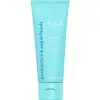What's inside
What's inside
 Key Ingredients
Key Ingredients

 Benefits
Benefits

 Concerns
Concerns

 Ingredients Side-by-side
Ingredients Side-by-side

Water
Skin ConditioningSolum Diatomeae
AbrasiveSodium Cocoyl Apple Amino Acids
Skin ConditioningGlycerin
HumectantAcrylates/Steareth-20 Methacrylate Copolymer
Acrylates Copolymer
Decyl Glucoside
CleansingDisodium Cocoamphodiacetate
CleansingPhenoxyethanol
PreservativeLauryl Glucoside
CleansingLithium Magnesium Sodium Silicate
AbsorbentPolysorbate 20
EmulsifyingHexylene Glycol
EmulsifyingSodium Hydroxide
BufferingCitrus Aurantium Dulcis Peel Extract
Emulsion StabilisingLimonene
PerfumingDecylene Glycol
Skin ConditioningEthylhexylglycerin
Skin ConditioningPanthenol
Skin ConditioningTetrasodium EDTA
1,2-Hexanediol
Skin ConditioningAscorbyl Glucoside
AntioxidantBorago Officinalis Seed Oil
EmollientTocopherol
AntioxidantHelianthus Annuus Seed Oil
EmollientTocotrienols
Skin ConditioningTriolein
Skin ConditioningTrilinolein
Skin ConditioningMagnesium Nitrate
Methylisothiazolinone
PreservativeMethylchloroisothiazolinone
PreservativeMagnesium Chloride
Water, Solum Diatomeae, Sodium Cocoyl Apple Amino Acids, Glycerin, Acrylates/Steareth-20 Methacrylate Copolymer, Acrylates Copolymer, Decyl Glucoside, Disodium Cocoamphodiacetate, Phenoxyethanol, Lauryl Glucoside, Lithium Magnesium Sodium Silicate, Polysorbate 20, Hexylene Glycol, Sodium Hydroxide, Citrus Aurantium Dulcis Peel Extract, Limonene, Decylene Glycol, Ethylhexylglycerin, Panthenol, Tetrasodium EDTA, 1,2-Hexanediol, Ascorbyl Glucoside, Borago Officinalis Seed Oil, Tocopherol, Helianthus Annuus Seed Oil, Tocotrienols, Triolein, Trilinolein, Magnesium Nitrate, Methylisothiazolinone, Methylchloroisothiazolinone, Magnesium Chloride
Sucrose
HumectantPropylene Glycol Dicaprylate/Dicaprate
EmollientOctyldodecanol
EmollientPEG-7 Glyceryl Cocoate
EmulsifyingMangifera Indica Seed Butter
Skin ConditioningCandelilla Cera
EmollientDisteardimonium Hectorite
StabilisingLactococcus Ferment Lysate
Skin ConditioningBromelain
Skin ConditioningPapain
Skin ConditioningLactic Acid
BufferingCarica Papaya Fruit Extract
Skin ConditioningCitrus Limon Fruit Extract
MaskingAnanas Sativus Fruit Extract
Skin ConditioningVitis Vinifera Fruit Extract
Skin ConditioningTocopheryl Acetate
AntioxidantWater
Skin ConditioningGlycerin
HumectantPropylene Carbonate
SolventButylene Glycol
HumectantSodium Chloride
MaskingSodium Benzoate
MaskingPhenoxyethanol
PreservativeParfum
MaskingLimonene
PerfumingBenzyl Salicylate
PerfumingButylphenyl Methylpropional
PerfumingSucrose, Propylene Glycol Dicaprylate/Dicaprate, Octyldodecanol, PEG-7 Glyceryl Cocoate, Mangifera Indica Seed Butter, Candelilla Cera, Disteardimonium Hectorite, Lactococcus Ferment Lysate, Bromelain, Papain, Lactic Acid, Carica Papaya Fruit Extract, Citrus Limon Fruit Extract, Ananas Sativus Fruit Extract, Vitis Vinifera Fruit Extract, Tocopheryl Acetate, Water, Glycerin, Propylene Carbonate, Butylene Glycol, Sodium Chloride, Sodium Benzoate, Phenoxyethanol, Parfum, Limonene, Benzyl Salicylate, Butylphenyl Methylpropional
Ingredients Explained
These ingredients are found in both products.
Ingredients higher up in an ingredient list are typically present in a larger amount.
Glycerin is already naturally found in your skin. It helps moisturize and protect your skin.
A study from 2016 found glycerin to be more effective as a humectant than AHAs and hyaluronic acid.
As a humectant, it helps the skin stay hydrated by pulling moisture to your skin. The low molecular weight of glycerin allows it to pull moisture into the deeper layers of your skin.
Hydrated skin improves your skin barrier; Your skin barrier helps protect against irritants and bacteria.
Glycerin has also been found to have antimicrobial and antiviral properties. Due to these properties, glycerin is often used in wound and burn treatments.
In cosmetics, glycerin is usually derived from plants such as soybean or palm. However, it can also be sourced from animals, such as tallow or animal fat.
This ingredient is organic, colorless, odorless, and non-toxic.
Glycerin is the name for this ingredient in American English. British English uses Glycerol/Glycerine.
Learn more about GlycerinLimonene is a fragrance that adds scent and taste to a formulation.
It's found in the peel oil of citrus fruits and other plants such as lavender and eucalyptus. The scent of limonene is generally described as "sweet citrus".
Limonene acts as an antioxidant, meaning it helps neutralize free radicals.
When exposed to air, oxidized limonene may sensitize the skin. Because of this, limonene is often avoided by people with sensitive skin.
The term 'fragrance' is not regulated in many countries. In many cases, it is up to the brand to define this term. For instance, many brands choose to label themselves as "fragrance-free" because they are not using synthetic fragrances. However, their products may still contain ingredients such as essential oils that are considered a fragrance.
Learn more about LimonenePhenoxyethanol is a preservative that has germicide, antimicrobial, and aromatic properties. Studies show that phenoxyethanol can prevent microbial growth. By itself, it has a scent that is similar to that of a rose.
It's often used in formulations along with Caprylyl Glycol to preserve the shelf life of products.
Water. It's the most common cosmetic ingredient of all. You'll usually see it at the top of ingredient lists, meaning that it makes up the largest part of the product.
So why is it so popular? Water most often acts as a solvent - this means that it helps dissolve other ingredients into the formulation.
You'll also recognize water as that liquid we all need to stay alive. If you see this, drink a glass of water. Stay hydrated!
Learn more about Water